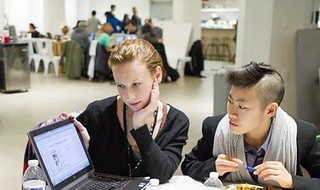How Was 2014 for Women in Tech?
Written by Alaina Percival
Guest author Alaina Percival is CEO and Board Chair of Women Who Code, a global non-profit dedicated to inspiring women to excel in technology careers. The organization has executed more than 1,200 free technical events around the world, garnered a membership exceeding 20,000, and has a presence in 15 countries. During this season of giving, please consider donating to Women Who Code.

It has been a banner year for Women Who Code (WWCode), a non-profit dedicated to inspiring women to excel in technology careers. We started as a community group a little more than three years ago and in 2014 we were poised to grow, but something even more fundamental shifted in our wider community. People are talking seriously about career paths in technology and, more specifically, about what we can do to get women and other under-represented groups into this increasingly important industry. Here’s a look at four of the most interesting trends and events we noticed over the last year:
1. Quantifying diversity transparently
At the end of 2013, Tracy Chou, an engineer at Pinterest, created an independent community report revealing the real percentages of women in engineering roles at some of the most prominent tech startups. Sadly, of the tech companies with more than 100 engineers, only Guidewire, Thoughtworks, and New Relic had a percentage of greater than 17% women engineers. Tracy’s report galvanized the largest companies in the tech industry to release their own diversity data, starting with Google ringing in at 17% women in engineering. Other major tech companies, including Yahoo!, eBay, and Facebook, quickly followed. The numbers are all devastatingly low, considering a little more than 50% of the population is made up of women. Despite that, the increased transparency is encouraging–serving as both a benchmark and (hopefully) a commitment to change.

2. Youth programs gain support
2014 has also seen tremendous support for and conversation around getting girls to code. Media mogul Oprah gave Black Girls Code founder Kimberly Bryant a Standing O-Vation, and the organization also received an Include Grant from Techcrunch. Girls Who Code expanded its summer immersion program to eight cities, more than doubling the number of girls it reaches. These amazing 20-person summer camps can transform the career trajectory of participants and have garnered support from some of tech’s most influential leaders, including Marc Andreessen and Dick Costolo.
One of the most impressive youth programs has been Code.org’s Hour of Code. The initiative attracted more than 80 million people, including President Barack Obama, and taught them basic coding fundamentals. This program isn’t exclusive to girls, but I will note that they created a “Frozen” Hour of Code example featuring the two heroines of the massively popular Disney film.
3. Engaging women in the tech community

As part of our mission to encourage and facilitate women to keep connected with others in the industry, WWCode sends a weekly newsletter to our audience of technical women. We include announcements for conferences and hackathons to encourage our members to further engage with the broader tech community. Going a step further, we also work hard to score a discount and a couple of free tickets to those conferences, and also start a dialogue with the organizers about their inclusions of women speakers, judges, and panelists.
This year, in an effort led by Google’s Women TechMakers leader Natalie Villalobos, Google I/O increased its proportion of women attendees from 8% to 20% for the 6,000 person conference. Natalie reserved a number of tickets for talented women, not limited to WWCode. This “list” also included PyLadies, Girl Develop It, and the Ada Initiative. We were thrilled to have women engineers flying in from all over the world to attend.
4. Highs and lows
The High: The CTO of the United States of America is Megan Smith. I’ve had the opportunity to meet Megan a couple of times and she is as sincere as she is inspiring.
The Low: Barbie coming out with a book letting girls know they needed to ask boys to help them code. Mattel pulled the book and apologized, but the fiasco clearly demonstrates a stigma still exists and is being taught to our youth.
Looking at it another way, perhaps the biggest high of the year is that the Barbie book became part of the conversation. I honestly feel like the world is ready to make a change. I believe we can see gender parity in the tech industry, we can close the wage gap, we can break down unconscious biases, and we can continue to reshape cultural norms so that women feel empowered to discuss their career successes.
Alaina Percival is CEO and Board Chair of Women Who Code
Originally published by New Relic on December 29, 2014.
Media Contact: Neal Brown | Chief of Staff
Address: Women Who Code HQ, 44 Tehama St, 5th Floor San Francisco, CA 94105
Email: press@womenwhocode.com